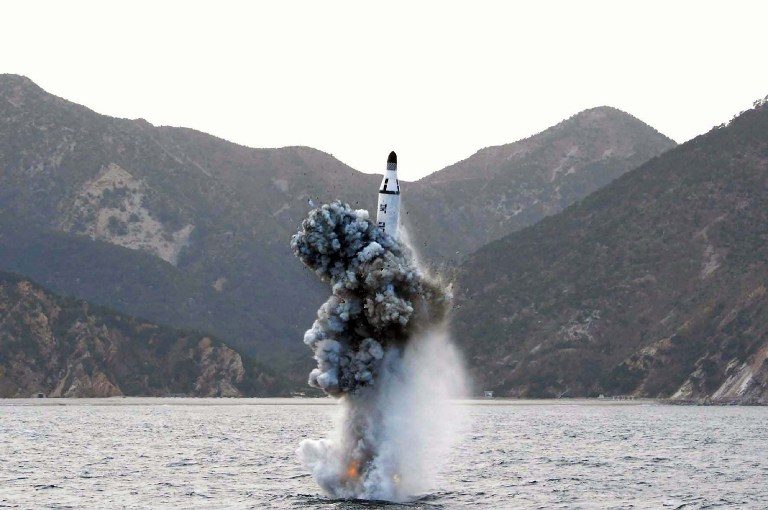SUMMARY
This is AI generated summarization, which may have errors. For context, always refer to the full article.

SEOUL, South Korea (3rd UPDATE) – North Korea on Wednesday, August 24, test-fired a submarine-launched missile 500 kilometers (around 300 miles) towards Japan, marking what weapons analysts called a clear step forward for its nuclear strike ambitions.
The flight distance, which was tracked by South Korea’s military Joint Chiefs of Staff, far exceeded any previous SLBM tests, suggesting significant progress in technical prowess.
A proven SLBM system would take North Korea’s nuclear strike threat to a new level, allowing deployment far beyond the Korean peninsula and a “second-strike” capability in the event of an attack on its military bases.
“While there are still a lot of questions about the details, this test certainly seems to have been successful,” said Jeffrey Lewis, director of the East Asia Nonproliferation Program at the Middlebury Institute of International Studies in California.
“This system is still in development, but North Korea is clearly making progress,” Lewis told AFP.
South Korea’s Yonhap news agency cited a military source as saying Wednesday’s launch had been made at an acute angle to limit the missile’s range.
If fired at the optimum angle, it could cover more than 1,000km, the source said.
Current UN resolutions prohibit North Korea from any use of ballistic missile technology, but Pyongyang has continued to carry out numerous launches following its 4th nuclear test in January.
South Korea has responded by agreeing to deploy a sophisticated US anti-missile system – known as THAAD – a move that has seriously strained relations with North Korea’s main diplomatic ally, China.
‘Effective countermeasure’
Lewis noted that an SLBM was an “effective countermeasure” to THAAD, and other missile systems with forward-looking radars, since the submarine can launch the missile from behind the radar.
Japanese Prime Minister Shinzo Abe said Wednesday’s missile breached his country’s Air Defense Identification Zone (ADIZ) and condemned what he called an “unforgivable, reckless act.”
Earlier this month, North Korea fired a land-launched ballistic missile directly into Japanese-controlled waters for the first time, drawing an outraged response from Tokyo.
The latest test came just days after North Korea threatened a preemptive nuclear strike against South Korean and US forces who kicked off their annual “Ulchi Freedom” military drill on Monday, August 22.
Seoul and Washington insist such joint exercises are purely defensive in nature, but Pyongyang views them as willfully provocative.
The South’s Joint Chiefs of Staff statement said that the North was clearly bent on escalating tensions and said the SLBM test posed a “serious challenge” to security on the Korean peninsula.
“We will deal strongly and sternly with any provocation by the North,” it said.
Washington also condemned the test and Pentagon spokesman Gary Ross said US commitment to the defence of allies South Korea and Japan remained “ironclad.”
Beijing expressed its opposition to North Korea’s nuclear and missile development hours after Pyongyang’s missile launch.
“China is opposed to North Korea’s nuclear and missile development process and any actions that trigger tensions on the Korean peninsula,” Chinese Foreign Minister Wang Yi said Wednesday after a meeting with the foreign ministers of Japan and South Korea in Tokyo.
Invasion scenario
The Ulchi Freedom drill plays out a scenario of full-scale invasion by the nuclear-armed North. It is largely computer-simulated but still involves around 50,000 Korean and 25,000 US soldiers.
The exercise always triggers a rise in tensions, and coincided this year with a particularly volatile period in cross-border relations following a series of high-profile defections.
Last week North Korea’s deputy ambassador to Britain, Thae Yong-Ho, defected to the South – a rare and damaging loss of diplomatic face for Pyongyang and a major PR victory for Seoul.
In comments clearly aimed at riling Pyongyang, South Korean President Park Geun-Hye said the “unpredictability” of supreme leader Kim Jong-Un’s character intensifies the dangers of further North Korean provocations.
North Korea has conducted a number of SLBM tests – most recently in April and July – with varying degrees of success.
Previous flight distances have not exceeded 30 kilometers, and the Joint Chiefs of Staff statement acknowledged that Wednesday’s test showed a marked improvement. – Rappler.com
Add a comment
How does this make you feel?
There are no comments yet. Add your comment to start the conversation.